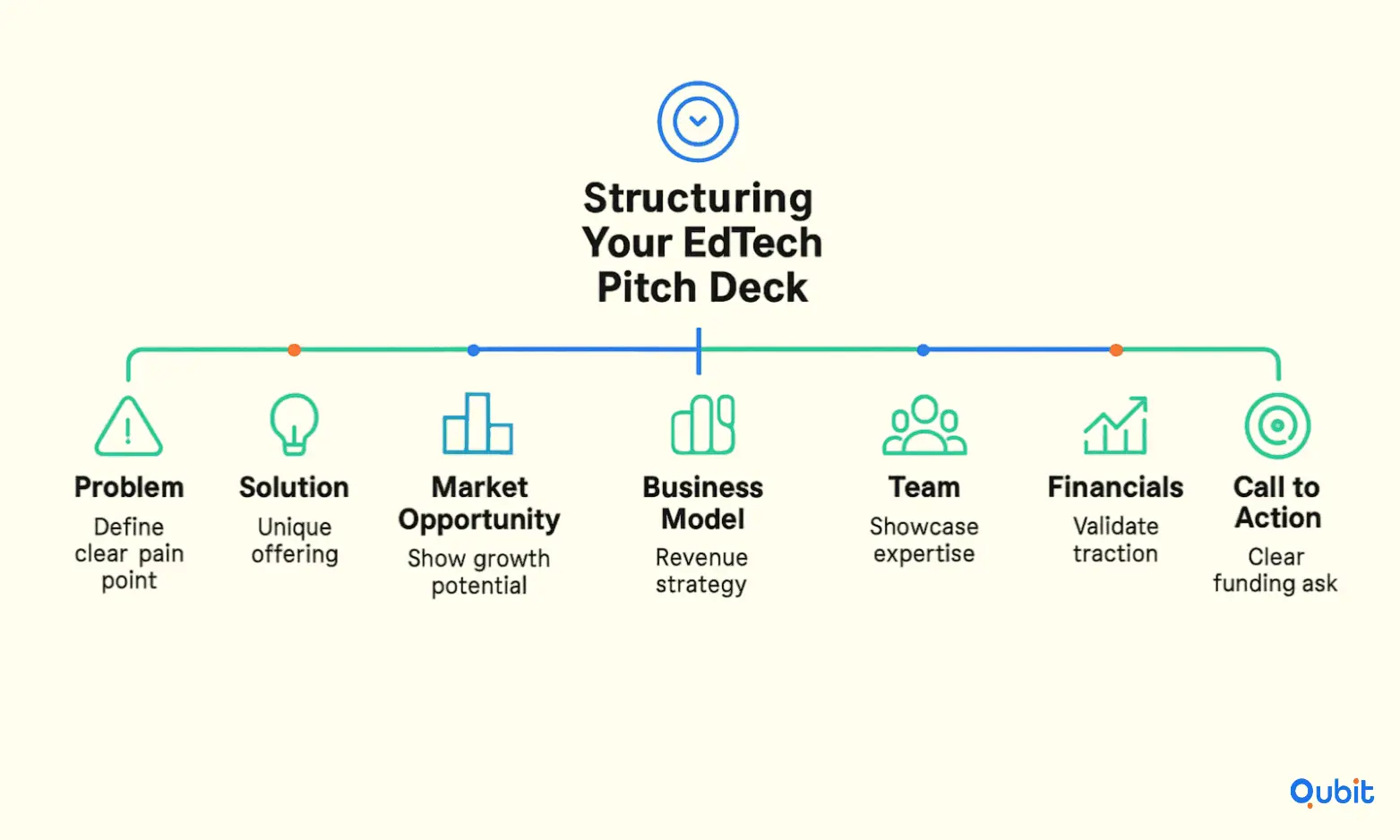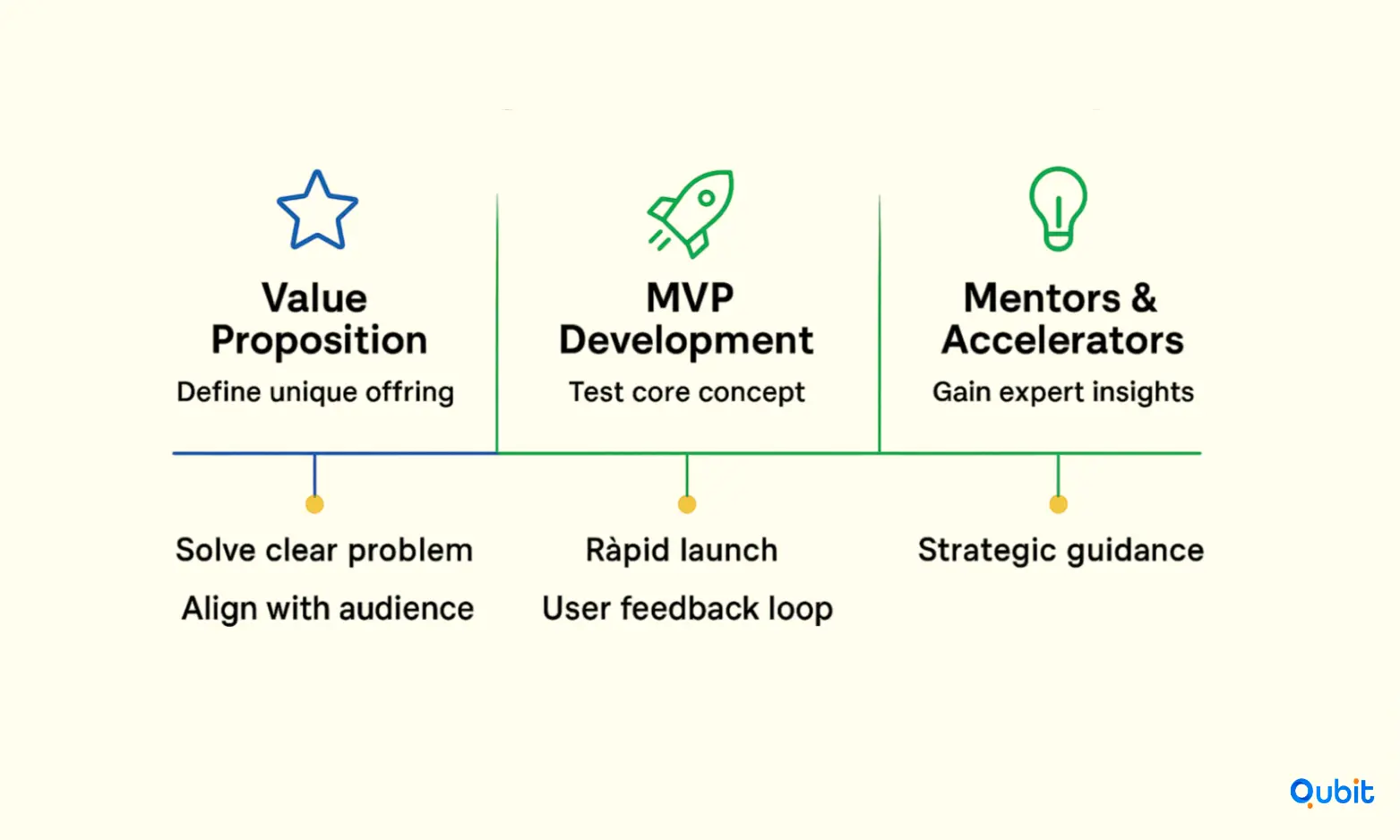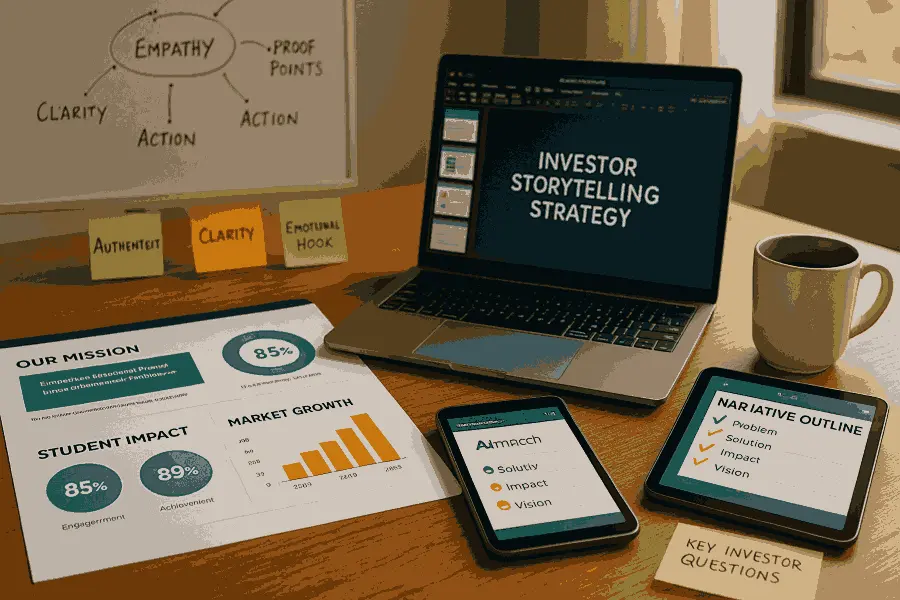A compelling pitch deck is the cornerstone of securing investor interest in the competitive EdTech space. It’s not just about presenting your idea; it’s about weaving a story that resonates with potential stakeholders. This blog is designed to help EdTech entrepreneurs create a pitch deck that combines vision, data, and strategy to meet investor expectations.
Your pitch deck’s design finds broader context in how to raise funds for edtech startups, aligning its components with the overarching fundraising strategies discussed there.
From structuring your narrative to showcasing market data, this guide will walk you through the essentials of crafting a pitch deck that stands out. Ready to build a presentation that bridges innovation with investor demands?
Let’s jump right in!
Understanding the Impact and Purpose of Your Pitch
A pitch is more than a presentation; it’s an opportunity to articulate a vision that inspires action. Particularly in the EdTech space, where innovation meets education, a pitch must go beyond numbers and charts. It’s about painting a picture of transformation, one that addresses a pressing problem and offers a solution that resonates with both logic and emotion.
Balancing Data with Storytelling
While market potential and financial projections are critical, they are not the sole drivers of investor engagement. Investors are drawn to clarity and conviction, but they also want to feel the weight of the problem you’re solving. This is where storytelling becomes indispensable. A compelling narrative can humanize your data, making it relatable and memorable. For example, instead of simply stating that a product improves learning outcomes by 30%, illustrate this with a story of a student whose life was changed by the solution.
The narrative nuances you consider in your presentation are examined further in the storytelling for edtech pitch deck, where the connection between storytelling and investor engagement is detailed.
Highlighting the Urgency and Promise
An effective pitch doesn’t just describe a problem; it conveys its urgency. Why does this issue need to be addressed now? What are the consequences of inaction? By framing the problem in a way that feels immediate, you create a sense of momentum that compels investors to act.
Equally important is showcasing the promise of your solution. This is where your vision takes center stage. Investors need to see not just the potential for financial returns but also the broader impact of your innovation. In EdTech, this could mean bridging educational gaps, democratizing access to learning, or preparing students for a rapidly changing world.
The Human Element
At its core, a pitch is about connection. Investors are not just evaluating your product; they’re evaluating you as a founder. Do you believe in your vision? Can you communicate it with passion and precision? A relatable problem statement, paired with a clear and confident delivery, can make all the difference.
By fusing hard data with emotional storytelling, your pitch becomes more than a business proposal—it becomes a call to action. It invites investors to join you on a journey of transformation, one that has the potential to reshape education for the better.
Structuring Your EdTech Pitch Deck
A well-organized pitch deck is essential for clarity and investor engagement. Each slide should serve a specific purpose, contributing to the overall story of your business. Below is a detailed framework to help you craft each component effectively.

1. Start with the Problem
Begin by identifying the core problem your EdTech solution addresses. Investors need to understand the pain points your target audience faces and why existing solutions fall short. Use concise language and impactful visuals to illustrate the problem clearly.
- Tip: Include real-world examples or statistics to make the problem relatable.
- Visual Design Insight: Opt for clean, uncluttered slides with bold headings to emphasize key points.
2. Present Your Solution
Once the problem is established, introduce your solution. Highlight how your product or service uniquely addresses the identified pain points. Focus on the benefits and outcomes rather than just the features.
- Tip: Use a combination of visuals and concise text to demonstrate how your solution works.
- Emotional Resonance: Share a brief story or testimonial that showcases the impact of your solution.
3. Showcase Market Opportunity
Investors want to see the potential for growth. Use this slide to present the size of your target market, key trends, and any gaps your solution fills.
- Data-Driven Validation: Incorporate charts or graphs to visualize market data.
- Clarity: Avoid overwhelming the slide with excessive information; focus on the most compelling metrics.
4. Outline Your Business Model
Explain how your EdTech company generates revenue. Whether it’s subscription-based, licensing, or freemium, provide a clear breakdown of your pricing strategy and revenue streams.
- Tip: Include projections to demonstrate scalability.
- Visual Design: Use diagrams or flowcharts to simplify complex models.
5. Highlight Your Team
Investors invest in people as much as they do in ideas. Dedicate a slide to showcasing your team’s expertise, experience, and passion for the mission.
- Tip: Include headshots, brief bios, and key achievements.
- Emotional Resonance: Emphasize the team’s commitment to solving the problem.
6. Financials and Traction
Provide a snapshot of your financial performance and key milestones. Highlight metrics such as revenue growth, user acquisition, or partnerships that validate your progress.
- Data-Driven Validation: Use graphs and charts to make financial data digestible.
- Clarity: Keep the slide focused on the most relevant metrics for your stage of growth.
7. Call to Action
End your pitch deck with a clear and compelling call to action. Specify the funding amount you’re seeking and how it will be used to achieve your next milestones.
- Tip: Be specific about the impact of the investment.
- Visual Design: Use bold text and contrasting colors to make the call to action stand out.
For a deeper analysis of structural elements, explore the edtech series a pitch deck, illustrating how your approach to series funding rounds can be refined for better investor alignment.
Balancing Emotional Resonance and Data-Driven Validation
A successful pitch deck strikes a balance between emotional appeal and factual evidence. While data builds credibility, emotional resonance creates a connection with investors.
- Emotional Resonance: Use storytelling to humanize your solution and demonstrate its impact.
- Data-Driven Validation: Back your narrative with metrics, charts, and projections to substantiate your claims.
By combining these elements, you can craft a pitch deck that not only informs but inspires.
Visual Design: A Key Differentiator
The design of your pitch deck plays a crucial role in capturing attention and conveying professionalism.
- Consistency: Use a cohesive color palette and font style throughout the deck.
- Clarity: Ensure text is legible and visuals are easy to interpret.
- Impact: Incorporate high-quality images or icons to enhance visual appeal.
Remember, a well-designed pitch deck reflects your attention to detail and commitment to excellence.
Crafting an effective pitch deck is a critical step in securing funding for your EdTech venture. If you're ready to take your pitch to the next level, we at Qubit Capital are here to support you with our Pitch Deck Creation service. Contact us today to get started.
Essential Resources to Enhance Your EdTech Journey
Expanding your EdTech startup requires more than just a great idea—it demands access to tools, networks, and opportunities that can propel your venture forward. Below, we’ve curated a selection of resources that provide structured support, mentorship, and community engagement to help refine your pitch deck and accelerate growth.
1. EdTech Accelerators and Incubators
Joining an accelerator program can be transformative for your startup. These initiatives offer structured mentorship, funding opportunities, and access to industry experts. For instance, ImagineK12 is a standout program designed specifically for EdTech startups. It provides tailored mentorship and guidance to help founders navigate the complexities of scaling their businesses.
2. Pitch Contests for Feedback and Exposure
Pitching your ideas to a panel of experts not only sharpens your presentation skills but also connects you with changemakers in the EdTech space. Consider participating in a specialized pitch contest like the one offered by Michigan Virtual, which provides valuable feedback, exposure, and access to a community of innovators. Learn more about the Power of Pitching in EdTech to elevate your startup’s visibility.
3. Building Collaborative Networks
Strong partnerships can amplify your reach and impact. Michigan Virtual, for example, collaborates with over 500 school districts, showcasing the scale of potential collaborations available in the EdTech ecosystem. Highlighting such partnerships can strengthen your pitch deck and demonstrate your ability to scale effectively.
4. Podcasts and Online Communities
Staying informed and connected is vital for any founder. Podcasts focused on EdTech trends and challenges can provide actionable insights, while online communities offer a platform for peer-to-peer learning and feedback. Engaging with these resources ensures you stay ahead of industry shifts and refine your strategies based on real-world experiences.
Accessing accelerators, mentorship opportunities, and community feedback can significantly boost your EdTech venture. By tapping into these resources, you gain accountability and strategic guidance that are essential for growth.
Transforming Concepts into Tangible Impact
Turning ideas into measurable outcomes is a challenge that requires more than just innovation. It demands a structured approach, combining strategic planning, pilot testing, and active collaboration with stakeholders. The journey from concept to tangible impact is not linear, but with the right tools and examples, it becomes achievable.
1. Strategic Planning: Laying the Foundation
A well-thought-out strategy is the backbone of any impactful initiative. It involves defining clear objectives, identifying potential challenges, and aligning resources to meet goals effectively. Strategic planning ensures that every step taken is purposeful and aligned with the desired outcomes.
For instance, EdTech platforms like Mentorcam have demonstrated the importance of strategic planning. By offering personalized coaching sessions with measurable engagement, Mentorcam secured $1.5M in seed funding after participating in an accelerator program. This success underscores how a robust plan can validate a concept’s viability and attract investor trust.
2. Pilot Programs: Testing and Refining Ideas
Pilot programs serve as a critical testing ground for new ideas. They allow organizations to assess feasibility, gather feedback, and refine their approach before scaling. Importantly, these programs should be supported by clear metrics to evaluate success.
Take the development of AI-Driven Low-Tech Solutions as an example. These tools are designed to operate in low-connectivity areas, making them ideal for underserved regions. By piloting such solutions, organizations can expand their addressable market while ensuring the technology meets the needs of its users.
3. Stakeholder Engagement: Building Trust and Collaboration
Engaging stakeholders early and often is essential for creating lasting impact. This includes investors, end-users, and community leaders who can provide valuable insights and support. Active collaboration fosters trust and ensures that the final product or service aligns with the needs of its audience.
When stakeholders are involved in the planning and pilot phases, they become advocates for the initiative, further amplifying its reach and impact.
Emerging Trends and Future Opportunities
The landscape of innovation continues to evolve, with trends like AI-driven solutions and personalized learning platforms leading the way. These advancements not only address current challenges but also open doors to new opportunities for growth and impact.
By focusing on strategic planning, leveraging pilot programs, and fostering stakeholder collaboration, organizations can transform their concepts into tangible outcomes that drive meaningful change.
Initiating Your EdTech Journey: Actionable Steps
Starting your EdTech venture requires a clear roadmap to ensure success. To get started, focus on building a strong foundation by identifying your unique value proposition and creating a minimal viable product (MVP) early in the process. These steps will help you establish credibility and attract initial interest from stakeholders.

1. Clarify Your Unique Value Proposition
Your value proposition is the cornerstone of your EdTech business. It defines what sets your solution apart from competitors and why users should choose it. Begin by identifying the specific problem your product solves and the audience it serves. For example, are you addressing gaps in personalized learning or simplifying administrative tasks for educators? Once defined, articulate this clearly in your pitch deck and marketing materials to ensure alignment across all communication channels.
2. Develop a Minimal Viable Product (MVP)
An MVP allows you to test your concept without investing excessive time or resources. Focus on delivering the core functionality that addresses your audience’s primary pain points. This approach not only validates your idea but also provides valuable insights into user behavior and preferences. Rapid development of an MVP ensures you can iterate based on real-world feedback, refining your product before scaling further.
3. Seek Feedback from Mentors and Accelerators
Engaging with mentors and accelerators early can significantly shape your strategy. These experts offer critical perspectives on your pitch deck, business model, and go-to-market approach. Their feedback helps you identify blind spots and refine your messaging. Additionally, accelerators often provide access to networks, funding opportunities, and resources that can fast-track your growth.
By taking these actionable steps, you’ll establish a solid foundation for your EdTech journey, ensuring your product resonates with users and stands out in the competitive market.
Conclusion
Crafting a compelling pitch deck requires more than just assembling slides; it’s about creating a narrative that resonates with investors. By focusing on clear problem identification, weaving a story-driven presentation, and aligning your data with investor priorities, you can significantly enhance your chances of success. A well-structured pitch deck doesn’t just inform—it inspires, showcasing your startup’s transformative potential.
If your raise needs to unify efficacy data, budget cycles, and privacy-by-design into one investable arc, we make it investor-ready. Move forward with our edtech fundraising assistance. Run a due-diligence dry run!
Key Takeaways
- A compelling pitch deck starts with a clear problem statement and a transformative solution.
- Storytelling and visual design are as critical as hard data when engaging investors.
- A structured, step-by-step approach builds clarity and investor confidence.
- Leveraging external resources like accelerators and online communities can accelerate your venture.
- Professional expertise in pitch presentation can elevate your narrative and secure funding.
Frequently asked Questions
What should be included in an edtech pitch deck?
A well-crafted EdTech pitch deck should clearly present the problem your solution addresses, the market opportunity, and your traction data. It must also highlight your business model and team credentials, all tied together in a compelling narrative format.






